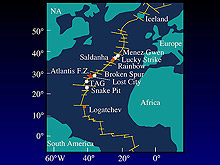
The Mid-Atlantic Ridge hosts numerous hydrothermal fields (colored dots). Logatchev, Rainbow and Saldahna are underlain by variable mixtures of deeper crustal rocks (gabbros and peridotite) and both Logatchev, Rainbow host high-temperature black smokers. The other fields are also sites of black smokers, but are hosted on volcanic rocks. Lost City is currently the only known hydrothermal field composed solely of carbonate chimneys. Click image for larger view and image credit. (HR)
Life is Full of Surprises
Deborah S. Kelley
Associate Professor
University of Washington
Jeffrey Karson
Professor
Duke University
Gretchen Früh-Green
Senior
Research Scientist
ETH-Zürich. Switzerland
Promise of Profound Discoveries within Our Oceans
For over two decades explorers of the deep ocean have been enthralled by underwater hot springs. These springs host organisms that live under some of the most extreme conditions on Earth. Black smokers, as the springs came to be called, have now been found throughout the mid-ocean ridge spreading system. Since their discovery, the billowing 360°C jets of metal sulfide- and gas-laden fluids were believed to typify submarine hot spring systems. They are oases for vibrant colonies of animals such as tubeworms, giant clams, and spider crabs whose symbionts depend on volcanic gases such as carbon dioxide (CO2) for survival.
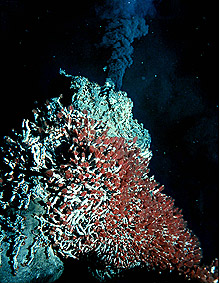
Part of a 360°C black smoker chimney with the Main Endeavour hydrothermal field on the Juan de Fuca Ridge in the N.E. Pacific ocean. Vibrant colonies of tube worms with red gills thrive on this large edifice, which is predominantly composed of iron- and sulfur-bearing minerals. Click image for larger view and image credit. (HR)
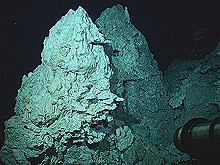
One of four pinnacles that form the summit of the 200-foot tall carbonate chimney called Poseidon in the Lost City hydrothermal field. The white chimney in the foreground is actively venting 55°C fluids. As the chimneys age they turn grey to brown in color, such as the one shown towards the back. Click image for larger view and image credit. (HR)
However, in 2000, a serendipitous discovery of an entirely new venting system was made. The discovery was as profound and surprising as that of the first smokers (Kelley et al., 2001; 2004). This new venting system, called Lost City was unlike any place ever previously visited. Investigation of this site is changing our views not only about the conditions under which life can thrive on our planet but on others as well.

The Atlantis Massif or mountain is bounded to the east by the slow-spreading Mid-Atlantic Ridge, and to the south by the Atlantis Transform Fault. The mountain rises ~14,000 from the seafloor and is a bit larger than the Cascade volcano Mt Rainer. In contrast to Mt. Rainer, however, the Atlantis Massif was not formed through volcanic processes but by long-lived faulting and uplift. The Lost City hydrothermal field is located near the top of the mountain (red star) on crust that is ~ 1.5 million years old. Click image for larger view and image credit. (HR)
Ghosts of the Abyss
Late one evening in December 2000, geologist Gretchen Früh-Green
was in the control room aboard the research ship the Atlantis watching
live video streamed to the ship from a robotic camera system 2100 feet
below. Cameras on the vehicle were imaging steep cliffs that form the Atlantis
Massif, a large mountain west of the spreading axis of the Mid-Atlantic
Ridge at 30°N latitude . During her watch, strange snow white
deposits of ghostly beauty came in and out of view, marking the discovery
of the field. Deborah Kelley and Jeffrey Karson embarked on a follow-on
dive using the human occupied submersible Alvin. On that dive they learned
that this place was like no other known site on Earth, hosting carbonate
(limestone) chimneys that towered 200 feet about the surrounding seafloor ![]() .
.
It was during this first dive that Lost City obtained its name because: 1) it is located ~15 km away from the spreading-axis of the Mid-Atlantic Ridge atop the 4000 m tall mountain called the Atlantis Massif, 2) the south face of the mountain is bounded by the Atlantis Fracture Zone (a fault similar to the San Andreas), and 3) the mother ship of Alvin is called the Atlantis. The forest of majestic tall white chimneys they observed on the discovery dive was reminiscent of Greek and Roman columns (the tallest chimney is called Poseidon after the Greek god of the sea). During the initial ~ 5 hour dive, only a few rock samples were collected from the limestone towers, but they gave us tantalizing glimpses into novel microbial communities that thrive within the 190°F fluids at this site. Follow-on investigation showed that not only is Lost City a habitat rich in microorganisms, but that it hosts vent fauna that may be more diverse than those at black smoker sites along the Mid-Atlantic Ridge.
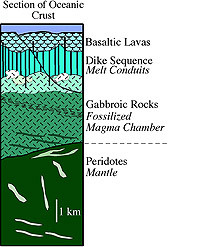
Generalized cartoon showing the various "layers" of rock that make up the oceanic crust. At Lost City, long-lived faulting has stripped off much of the overlying crustal material, which has resulted in exposure of peridotite rocks at the surface of the seafloor. Click image for larger view and image credit. (HR)
Deforming Rocks Build Mountains in the Sea
The Atlantis Massif has had a tough life. During its 2 million year history, the rocks that make up this mountain have undergone dramatic changes. To understand their amazing history, we need to first take a look at "normal" oceanic crust, which may be portrayed in a simple sense as a series of layers made up of different rocks. If you could slice open a generalized piece of crust, starting at the deepest parts, you would find rocks called peridotites that are comprised mostly of the mineral olivine [a mineral that is rich in magnesium, iron, and silica -(Mg, Fe)2 SiO4].
The peridotites form a region or layer deep within the Earth that geologists and geophysisists refer to as the mantle. Beneath spreading centers, large convection cells cause the mantle rocks to rise up to shallow depths. As they do this, the peridotites start to melt, and as the melt progressively coalesces into larger and larger conduits, it rises closer and closer to the seafloor. At a depth of <1-5 km beneath the seafloor, large accumulations of melt may pond to form magma chambers-holding tanks for 1200°C molten material. When this material cools and solidifies, it is called a gabbro. Sometimes so much melt accumulates that the top of the magma chamber cracks, ejecting huge volumes of melt along linear conduits that rise to the seafloor. If the melt reaches the seafloor, an eruption ensues—similar to underwater eruptions on Iceland or Hawaii. The solidified conduits are called dikes, and the cooled lava flows are made up of rocks called basalts.
So, what about the Atlantis Massif? Particularly at slow spreading centers such as the Mid-Atlantic Ridge, vertical movement of the crust causes extensive faulting that commonly completely disrupts the ordered layer of the crust. Think of what happens when you push a deck of cards with one hand on the bottom while having your other hand rest on the top. The entire section of cards (layers of crust), slide past each other. In the case of the Atlantis Massif, this uplift and sliding has caused the upper layers of the crust (basalts, dikes, and most of the gabbros) to be "stripped" off, leaving only the mantle with lesser gabbroic rocks exposed at the seafloor.

Altered peridotite from the cliffs beneath Lost City. The dark colored material is composed dominantly of the mineral serpentine, which forms when seawater interacts with the mineral olivine. The rounded gray patches are magnesium- and iron- and silica-bearing minerals called enstatite. This sample is typical of mantle material recovered from the seafloor. Click image for larger view and image credit. (HR)
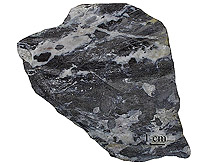
Deformed gabbro from the Atlantis Massif. Many of the rocks recovered from near the top of the mountain are highly deformed because of long-lived faulting. This rock has slowed coolly within a magma chamber. This rock was likely deformed at temperatures in excess of 700°C. Click image for larger view and image credit. (HR)
This faulting process has important consequences for formation of Lost City and the life that it holds. Because the mantle rocks were formed under very high pressures and temperatures, when they are exposed to seafloor conditions they are extremely unstable or out of equilibrium with the surrounding seawater. Interaction with seawater along the faults and fractures releases heat and the gases methane (CH4) and hydrogen (H2). Heating of the fluids causes them to rise, drawing in cooler water behind their wake. The upwelling fluids when they reach the seafloor vent at temperature up to 90°C and are enriched in CH4 and H2.

Microphotograph of micro-organisms that were living inside the chimneys at Lost City. The organisms are stained with a special chemical that causes them to show up under filtered light. This images shows a very large colony of microbes-each individual dot is a single cell about 1 micron across. The colonies form biofilms on the surfaces of carbonate minerals. Click image for larger view and image credit. (HR)
Life-Supporting Rocks
The microorganisms at Lost City have adapted to this extreme environment and have learned to make their living off of the gases and heat released from the rock. Dense communities of microbes thrive within the warm interiors of the carbonate chimneys, which are bathed in warm, CH4- and H2-rich fluids that have properties similar to ®Drano. On the outside of the chimneys, where fluid mixing occurs, the microorganisms use some of the elements in seawater and some of the elements in the hydrothermal fluids for their energy and cell-building materials. Based on study of their DNA, some of these organisms are similar to those that live in methane-ice deposits along the margins of many continents. Within Lost City some of organisms may produce methane, while others oxidize it for energy. The microbes are slow in giving up many of their secrets however, because they are very difficult to grow in the laboratory.
Our Changing Views of Life
Since the initial discovery of Lost City ![]() in 2000, we have been back once
in 2003 for a 19-day expedition using the 3-person submersible Alvin, where
numerous samples of rocks, fluids, and biology were recovered.
What we are finding is changing our views about where life can not only
survive on this planet, but actually thrive. The mantle rocks that Lost
City rests on are not the youngest and hottest on our planet (such as the
basalts that are erupted along the ridge systems), but instead are up to
2 million years old and located far way away from the spreading center.
Recent exploration studies now show that the ocean floor may host vast,
exposed deposits of mantle rocks. This appears to be particularly true
in regions of the Arctic and Antarctic oceans. If this is true, then Lost
City-type vent systems may be common throughout the world’s oceans,
highlighting the fact that there is much yet to be discovered about our
own planet.
in 2000, we have been back once
in 2003 for a 19-day expedition using the 3-person submersible Alvin, where
numerous samples of rocks, fluids, and biology were recovered.
What we are finding is changing our views about where life can not only
survive on this planet, but actually thrive. The mantle rocks that Lost
City rests on are not the youngest and hottest on our planet (such as the
basalts that are erupted along the ridge systems), but instead are up to
2 million years old and located far way away from the spreading center.
Recent exploration studies now show that the ocean floor may host vast,
exposed deposits of mantle rocks. This appears to be particularly true
in regions of the Arctic and Antarctic oceans. If this is true, then Lost
City-type vent systems may be common throughout the world’s oceans,
highlighting the fact that there is much yet to be discovered about our
own planet.
Systems similar to Lost City were likely also more common during early Earth formation when rocks similar in composition to mantle rocks were erupted directly onto the ancient ocean floor. If so, study of Lost City may yield new insights into how life first evolved on our planet and by analogy, elsewhere in the solar system.
Kelley, D.S. J.A. Karson, G.L. Früh-Green, D.A. Yoerger, D.A. Butterfield, J. Hayes, T. Shank, M.O. Schrenk, E.J. Olson, G. Proskurowski, M. Jakuba, A. Bradleey, B. Larson, K. Ludwig, D. Glickson, K. Buckman, A. S. Bradley, W.J. Brazelton, K. Roe, M.J. Elend, A. Delacour, S. M. Bernasconi, M.D. Lilley, J.A. Baross, R.E. Summons, S.P. Sylva 2005 A serpentinite-hosted submarine ecosystem: The Lost City Hydrothermal Field. Science, 307, 1428-1434.
Kelley, D.S., J.A. Karson, D.K. Blackman, Gretchen Früh-Green, Jeff Gee, D.A. Butterfield M.D. Lilley, E. J. Olson, M.O. Schrenk, K.R. Roe, and Shipboard Scientific Party, 2001 An off-axis hydrothermal field discovered near the Mid-Atlantic Ridge at 30°N. Nature, 412, 145-149.

























